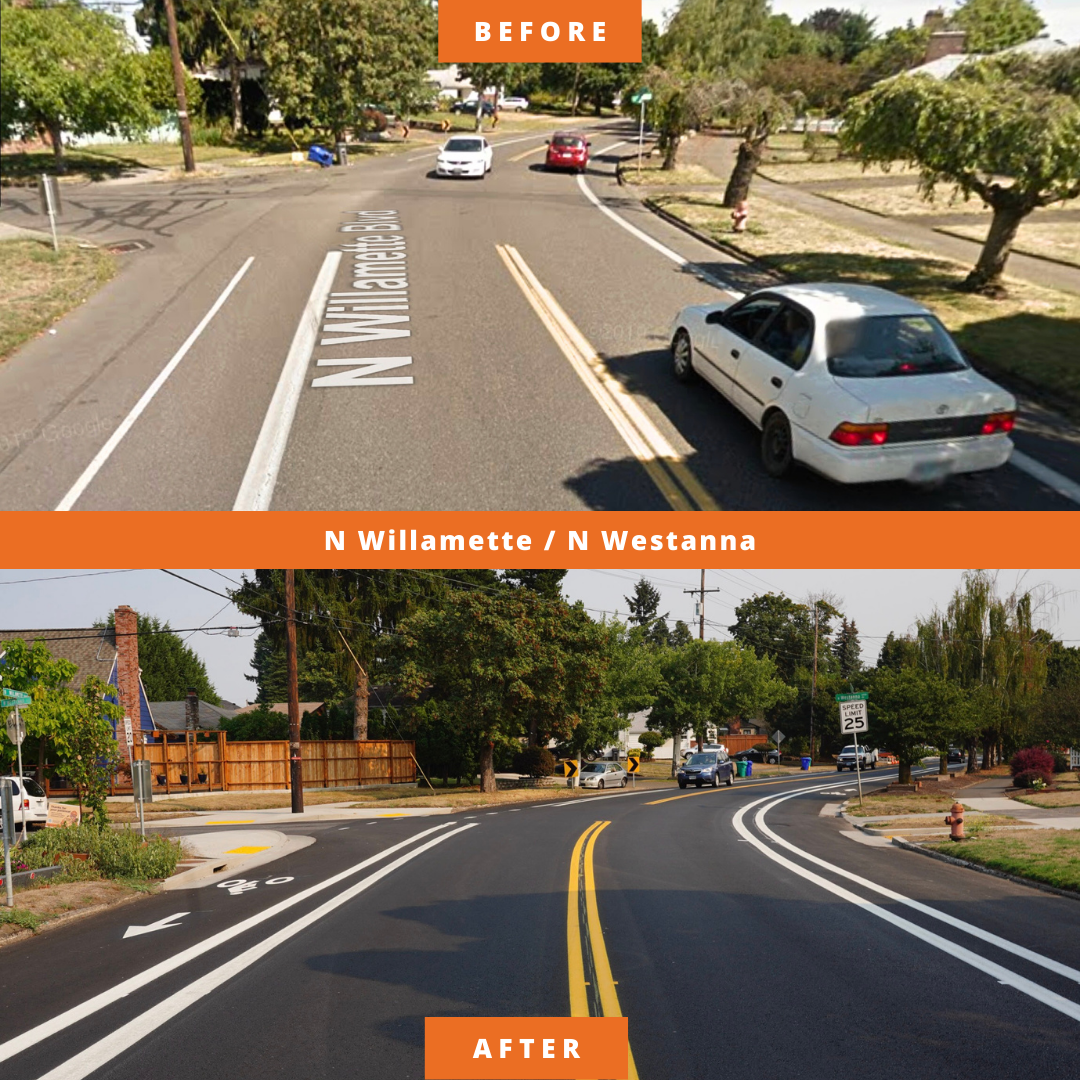
Last month the Portland Bureau of Transportation took a step forward on their plan to transform North Willamette Boulevard into a high-quality cycling street. As I shared in an Instagram video back in July, PBOT seized the opportunity of a repaving project on the street to make a significant upgrade to the bike lane striping on a 0.7-mile section between University of Portland and the entrance to the Peninsular Crossing Trail at the railroad cut.
PBOT has removed on-street parking on both sides of the street between N Portsmouth and N Carey in order to widen and add a buffer zone to the bike lanes in both directions. This was done in advance of the full build-out of their North Willamette Boulevard Active Transportation Corridor project which is set for construction in 2025. In addition to the nice new pavement and wider bike lanes, PBOT has upgraded the curb ramps to ADA standards and added a few other improvements.
Below are some photos of the new bike lanes…
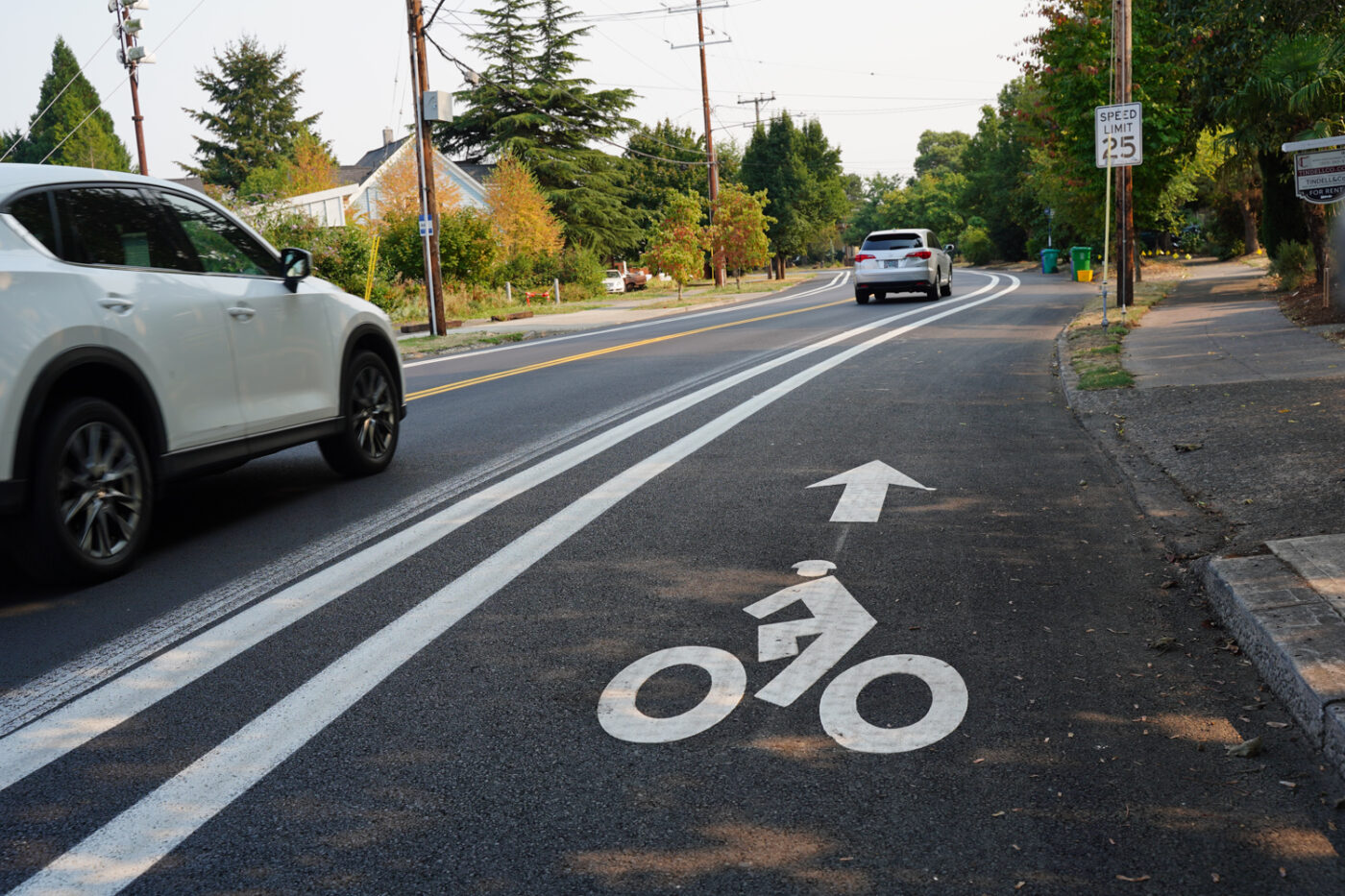
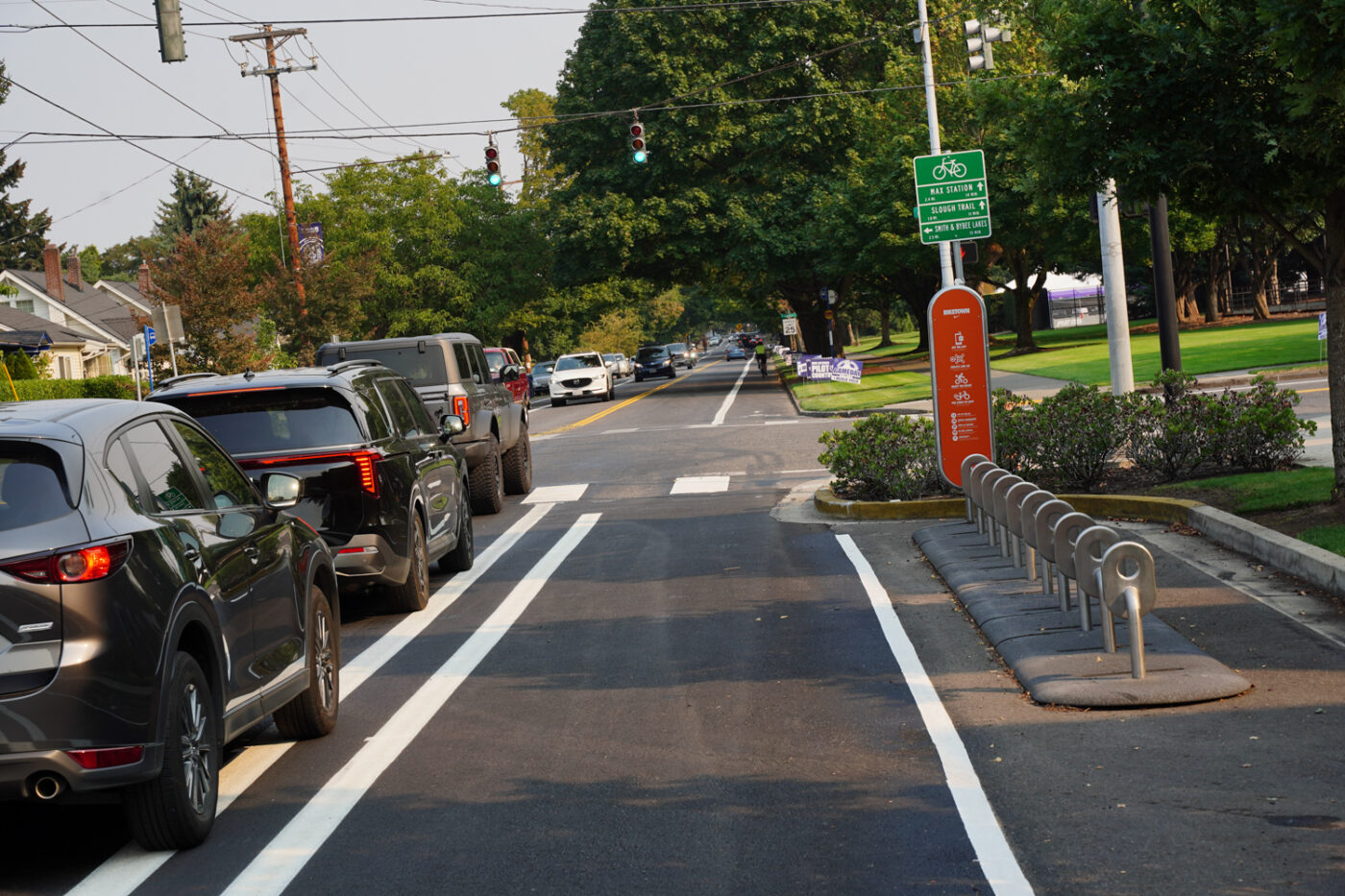
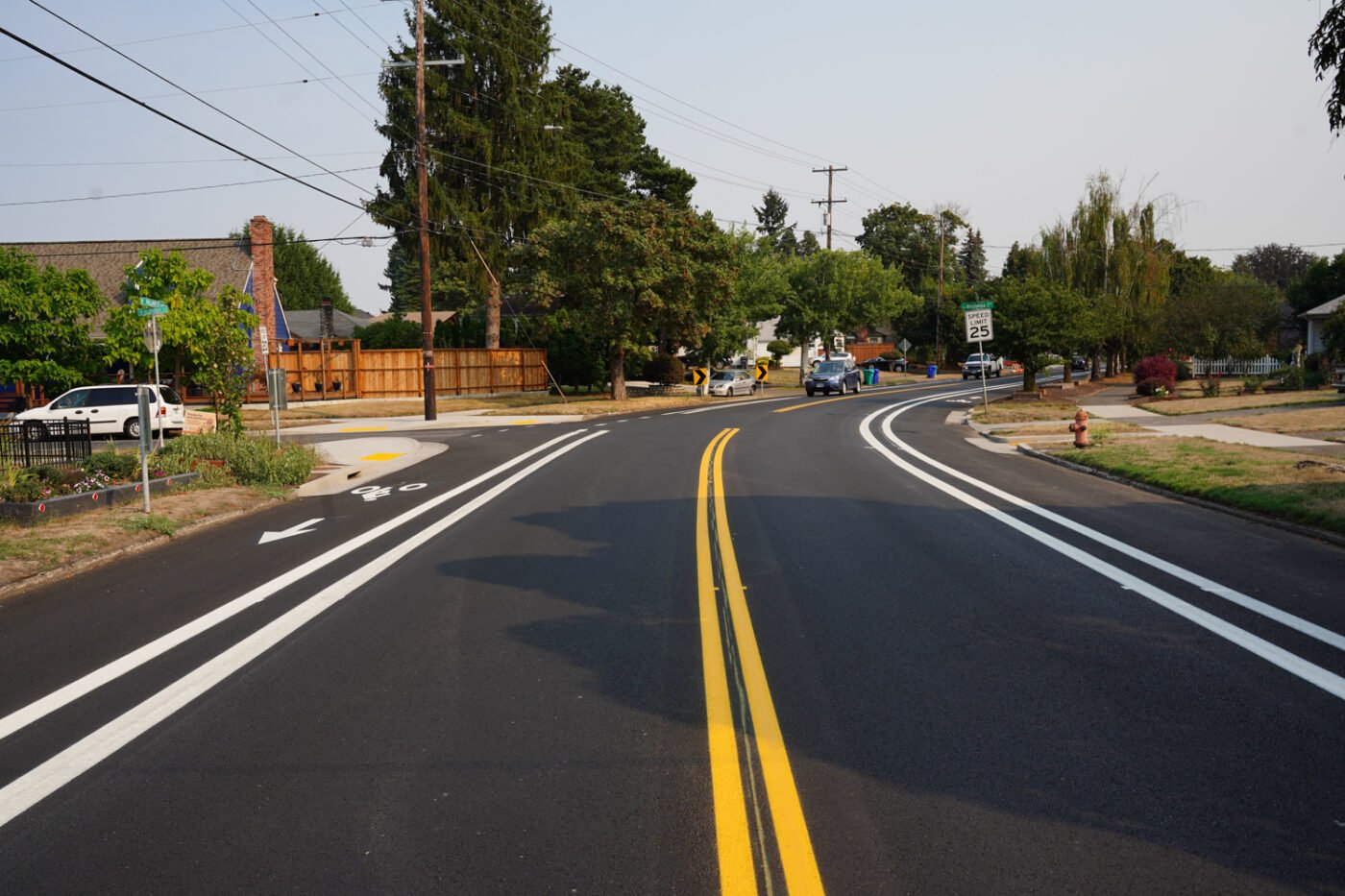
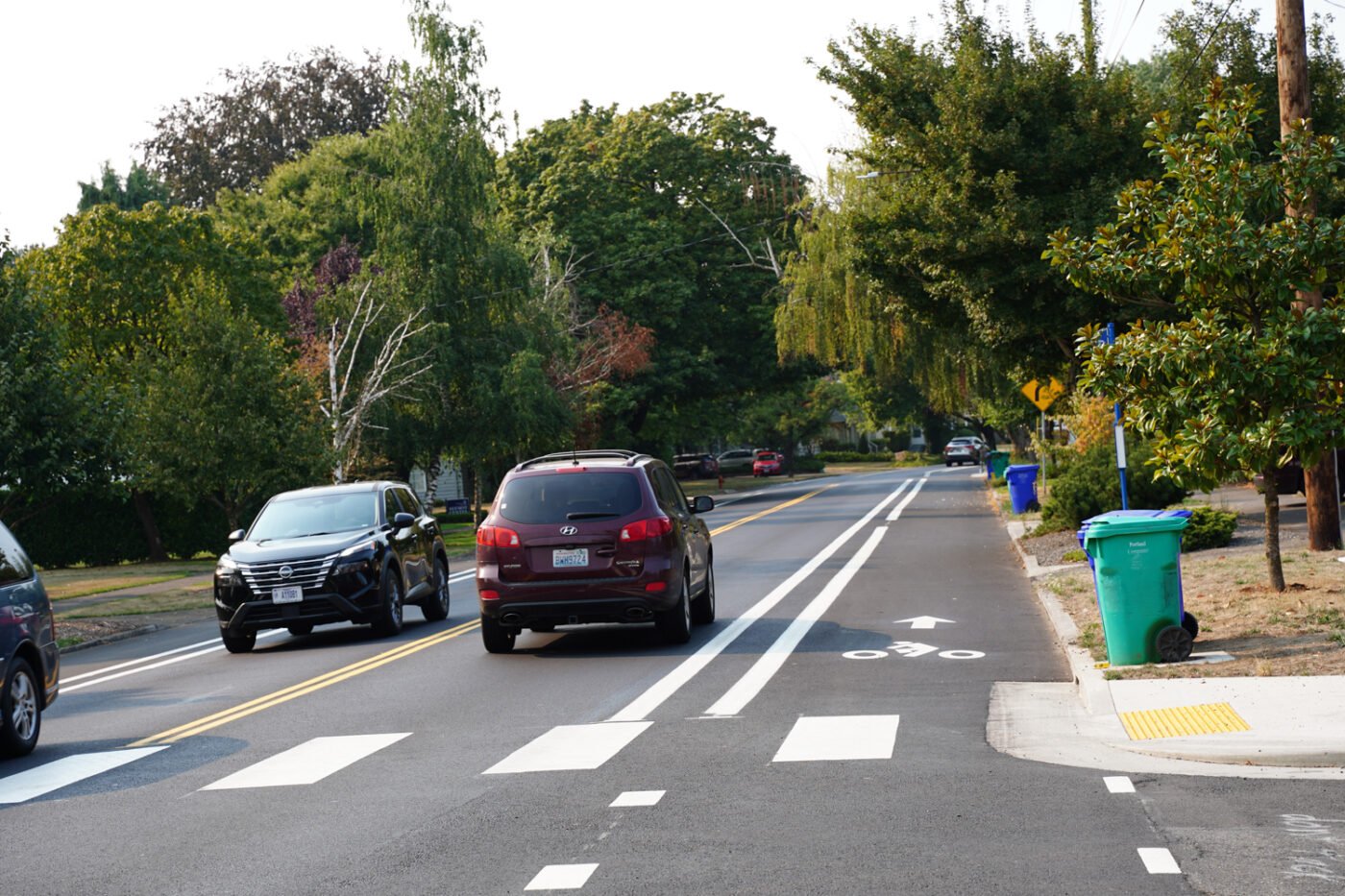
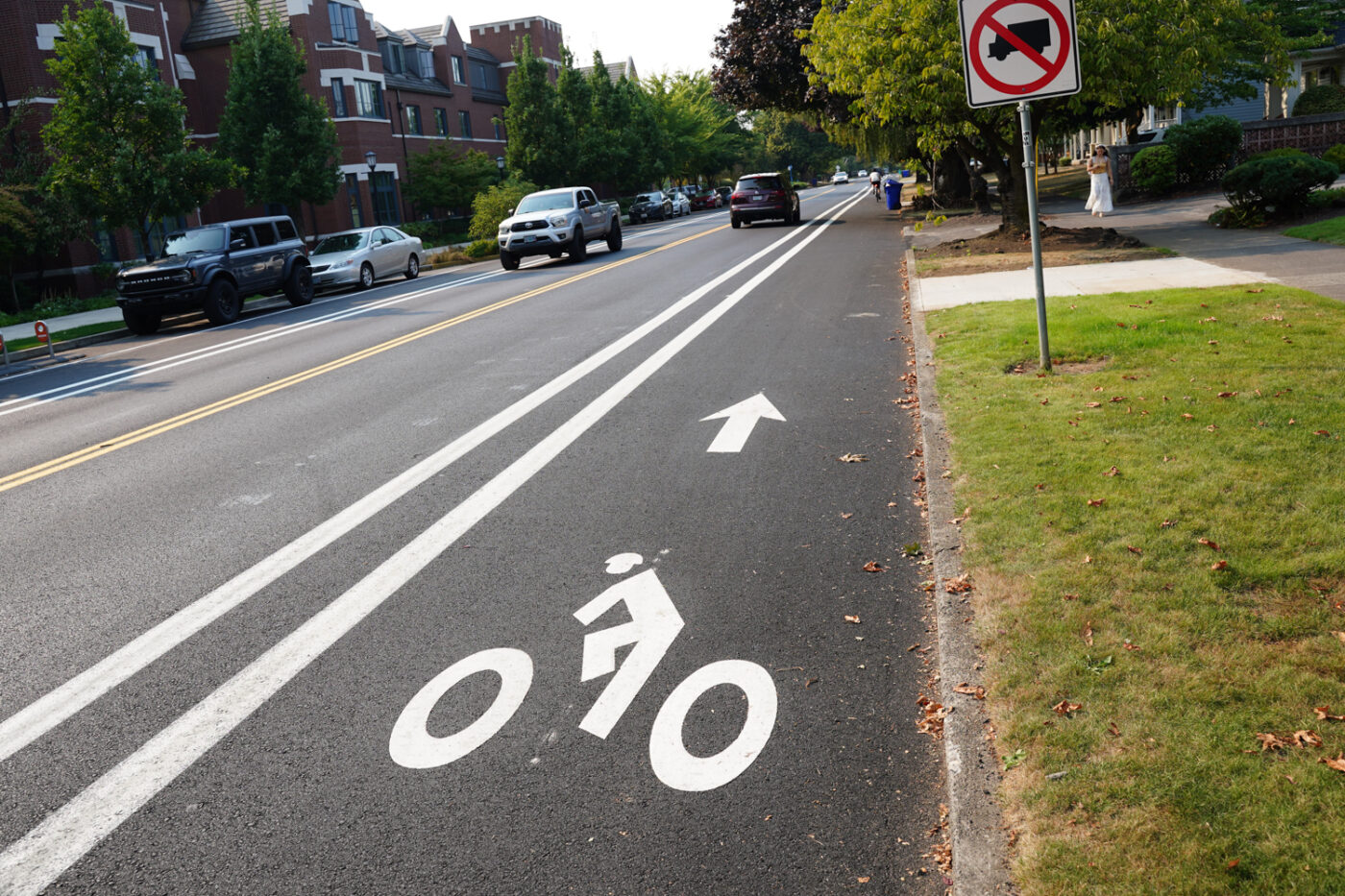
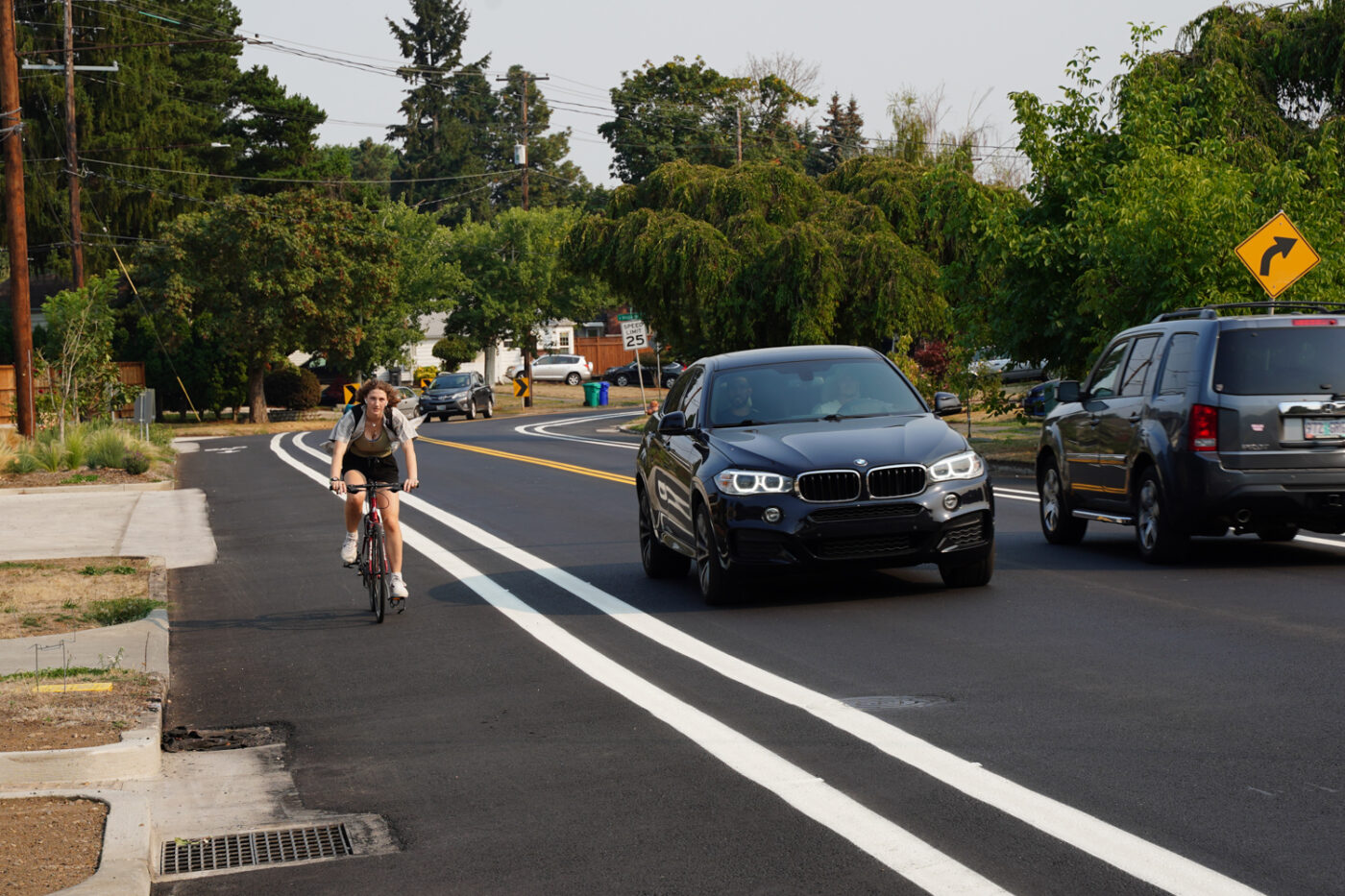
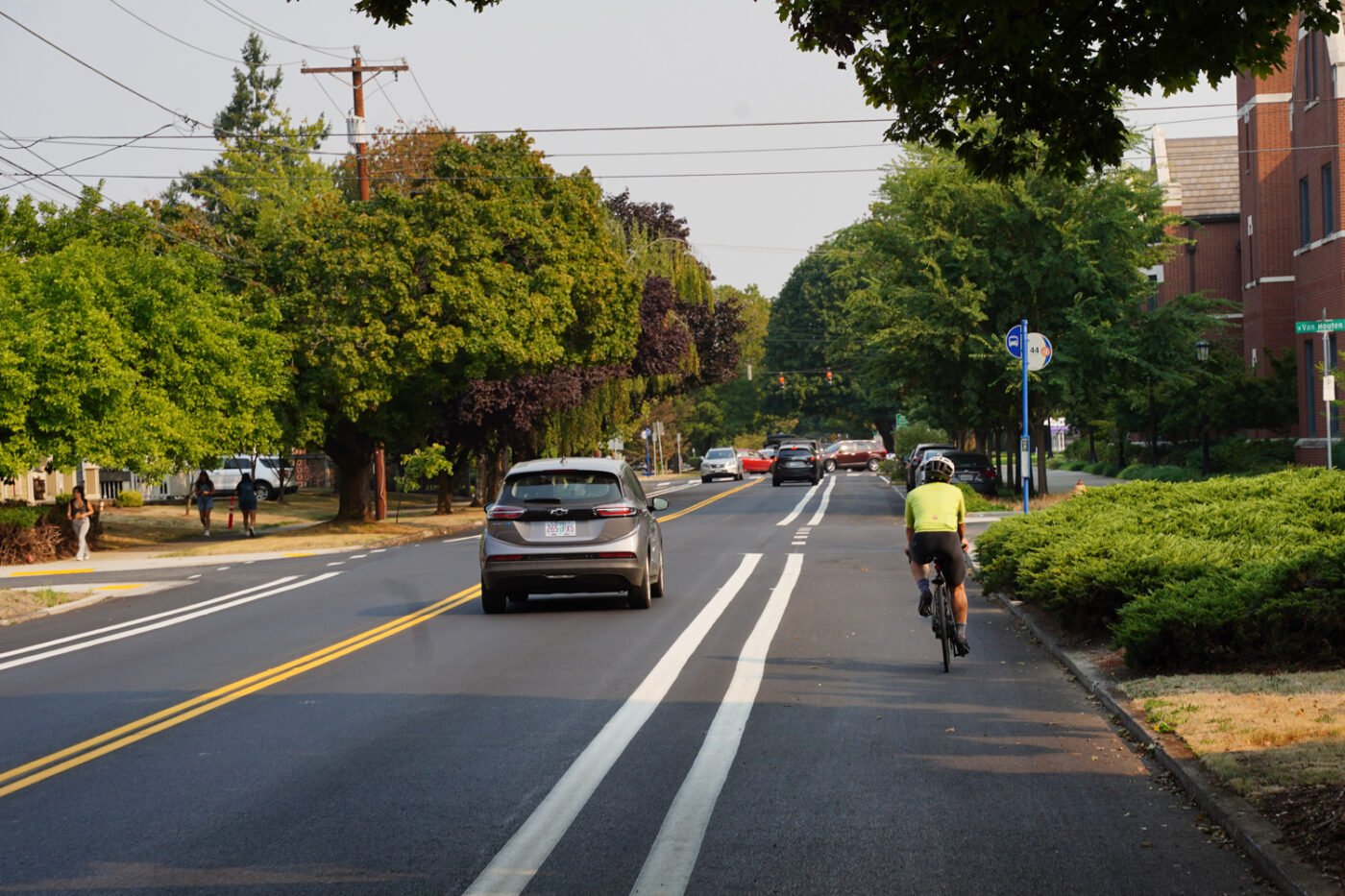

When I was away on vacation, I saw a Reddit post that shared frustration about drivers who had parked their cars in the newly striped bike lanes. I rode the section yesterday around 4:00 pm and no one was parked in them. Keep in mind that whenever PBOT makes changes like this, we almost always see a lot of folks disregard the new lanes and park in them. This is very frustrating (and sometimes dangerous), but experience tells us that eventually drivers figure things out and it gets better. (You can report illegally parked cars via the city’s PDX Reporter tool or the police non-emergency line.)
With school back in session, the timing of these newly-widened lanes could not have been better. While I was out there yesterday I saw several folks on bikes who I suspected to be University of Portland students. In terms of how these bike lanes work; they’re just very straightforward, curbside buffered bike lanes so there’s nothing surprising to report.
Another cool thing PBOT has added is a new curb extension with a bicycle slip lane and a median crossing at N Macrum that narrows the wide intersection and reduces stress for all users.



The new curb extension and bike slip lane at N Macrum. (Sorry didn’t get a wide shot. These are taken from a video I’m putting together for social media.)
Please note that this treatment is just an interim and PBOT plans to harden these lanes with concrete curbs when the full project is completed. Have you ridden these new bike lanes? Did you see folks parking in them? What was your experience?
(Video below just posted to Instagram)






Thanks for reading.
BikePortland has served this community with independent community journalism since 2005. We rely on subscriptions from readers like you to survive. Your financial support is vital in keeping this valuable resource alive and well.
Please subscribe today to strengthen and expand our work.
Good to see these improvements. I ride Willamette a fair amount on my favorite longer loop (Leif -> Saltzman -> Skyline -> Germantown -> Willamette back to SE) and it’s always been annoying how poor the lane was there. Really excited to see more progress come once the full project breaks ground
While I’m all for the new bike lanes, your loop requires crossing the St. John’s Bridge, which I find scary AF, and riding S from St. Johns to the bridge over the rail cut. This last section needs bike lanes way more than the repaved section. Don’t get me wrong — I’m super happy to see the improved bike lanes, but it does not meaningfully decrease the risk and discomfort of riding through the stretch. Yet.
That section of Willamette Blvd between St Johns and the railroad cut is getting bike lanes in the next few months!
Yeah… I can’t wait!
This section now has nice bike lanes! Thanks, PBOT — the improvements to Willamette this summer are a good example of feasible improvements that make a big difference.
You find riding on the St Johns bridge scary, but no concern about riding on skyline? I ride it occasionally, as do many other cyclists. But the complete lack of facilities, poor sightlines, and difficult gradients would be a non starter for many non strong and freestyles cyclists.
Hi Sarnia, I didn’t say I had no concerns about Skyline — I would love to see improvements there. Personally, I think the Germantown segment is worse than Skyline, and both are better than the bridge. The St. Johns Bridge is on many potential routes and strikes me as a key segment that is particularly difficult to bike through.
The St. Johns Bridge is definitely not for the faint of heart, but it’s one of my favorite looking bridges in the world. Plus I love riding over it and seeing Mt. Adams through the gothic arches on a clear day. And I feel that even if the infrastructure is nonexistent, there’s some rides that are just worth it anyways. It’s like riding the coast. Definitely will have lots of uncomfortable experiences, but I still recommend it to people especially if they have friends to ride it with (with caveats of course)
Have you considered the Nestucca or Trask routes? A lot less cars.
I love the Netsucca route to the coast, hoping to get a ride on it this year before the rain really comes back. Haven’t done the Trask before – do you have a good route handy? I was nervous about a potential washout last time I looked (maybe two years ago)
Oh yes. But it’s fairly straightforward. Maybe check on a local bikepacking group I think it’s called “Our mother the mountain” for info/gpx. A quick search on rwgps gave me this. Basically, you ride from Forest Grove, pass Barney Res, follow the N fk and then the Trask R. It’s better than the Nestucca only in one aspect: you can avoid riding on 101 since it spits you out right at Tillamook. Have fun!
looks like a great route! thanks so much
Looks nice!
What’s people’s experience with PBOT’s enforcement response for cars parked in bike lanes? I did it once via PDXreporter-nothing happened and the car was still there the following day and no ticket. Is that typical or have others seen a response from their reports?
I’d guess it’s helpful for getting concrete put in, but it seems like nobody there cares or can do anything about a car in the bike lane
I’ve rarely seen results from using PDX Reporter for parking issues. They once replied to my email and said they only check it during something like 9-5 on weekdays. It’s clearly not a priority for them. Waiting through the brutally slow listing of menu options and remembering the 100 different pieces of information you need to list while calling them seems to work a little better.
Nice work, PBOT. I’m excited to try them out.
Folks, if you like what you see here, be sure to send your public servants at PBOT a friendly “Thank you.”
General contact line
safe@portlandoregon.gov
PBOT Director Millicent Williams
Millicent.Williams@portlandoregon.gov
Generally, if folks get a little appreciation for what they do, they’re likely to do it more often.
Ted Buehler
It absolutely helps when people contact the city about things that they like, and not just things that they don’t like.
The new lanes are nice! I’ve ridden them twice (once towards St. Johns, encountering two cars parked in the bike lane, and once both ways with no cars parked in the bike lane).
Oh how cute! Painted shared bike and car HOV lanes on Willamette! Look, they even have those cute bike symbols! So progressive for the 1990s, PBOT must of hired some of our incompetent NC State U stroad engineers to design it. What will they think up next?
I think these lanes are sufficient for this stretch, personally. You have to ride through way worse to get on these (unless your trip endpoints are very near Willamette). I would love even skinny bike lanes all the way to St. Johns and especially over the bridge.
An upcoming project will install concrete barriers. Would be nice to read comments here that don’t drip with snark but have something helpful (dare I say “hopeful”) to offer.
David — just an FYI — Portland, OR doesn’t maintain curb protected bike lanes.
I bicycled on SE Division the other day from 148th to 117th.
When new, ~3 years ago, these bike lanes were narrow, but you could ride in them if you payed attention.
Now, they are pretty much unrideable.
I encountered the usual. And lots of it:
• broken glass
• leaves
• gravel
• sod
• sunken storm drains
• encroaching tree branches.
(All standard fare for a bike lane in Portland, OR, summer 2024. But worse with concrete curbs because occasional car/truck drivers aren’t pulling in and out)
And with a concrete curb, I couldn’t duck out of the bike lane to avoid them.
I also encountered:
• a plastic wand bent over into the bike lane
• a concrete curb broken and shoved into the bike lane.
• possibly a few other artifacts of failing “protection infrastructure”, but I don’t recall them.
Note also that I’ve made maintenance requests for these types of problems in SE Division many times over the last three years, with no long-term improvements to date. (I’m still trying).
So, while you might equate these new bike lanes on a slow speed residential street with those out in by the North Carolina DOT, these bike lanes are actually the cat’s meow, in my opinion.
Protection isn’t needed here. I bike Willamette Blvd a lot. It’s a friendly street. I routinely report plugged storm drains, encroaching tree limbs, broken glass here, and it gets taken care of. There’s not much of it anyway.
And, like you, I lived in Metro Portland OR in 2008, when the city reached 8% of commute trips done by bicycle. And had zero miles of “protected bike lanes”.
So, I’m curious as to why you don’t like these?
Come visit sometime, we can ride on Willamette Blvd, ride on SE Division.
Cheers,
Ted Buehler
Still at ted101@gmail.com
The lack of maintenance on the division bike lane is frustrating. I find it hard to imagine that a street sweeper has ever been out there.
Hey Ted,
I get that physical separation is something relatively new to Portland and sometimes unpopular. I also get that Portland does not maintain its bike lanes (why I simply ride mtn bike tires most of the time). Many of the “old timers” (not a pejorative) hold your opinion, and simply don’t see the benefit of physical separation. I remember talking to a bike shop owner on Hawthorne who promoted vehicular cycling and was staunchly against building PBLs. Often people holding this view point to the 8% modal share that Portland had two decades ago as a type of evidence that physical separation doesn’t really matter. The problem with this view is that it is not borne out by the decades of research on cycling infrastructure, and is really only debated in places like Portland, where there is no separated network aside from downtown.
Physical protection is absolutely needed on Willamette Blvd (and most major bikeways that share space with cars traveling more than ~20mph. It may not be needed by a lot of people currently cycling (whose threshold for danger allows them to use these facilities), but it is needed for people who almost never bike because they feel unsafe. The vast majority of people who are “interested but concerned” will not walk in the street next to 30mph car traffic, just as they will not bike next to the same.
To be honest it is very concerning that you are promoting this view. Everyone who rides a bike must figure out how to empathize with people who are less abled, who are much older or younger, who identify as female, who are less athletic etc. Otherwise we will continue to promote an ideology seeped in our own feelings and anecdotes, and one that is not reflected by decades evidence.
I would add that basic 6″ or 8″ cleated curbs (either plain concrete gray or striped black and yellow) would easily fit between the white lines, something I saw frequently in Charlotte and DC, which also has the added benefit of keeping drivers out of the bike lane, particularly on curves (even one of the photos above show a car driver encroaching on the bike lane.) In addition, removing the center yellow lines has been proven again and again to slow car drivers down, even down to the speed limit (rather than 20 mph over it), with the very real threat of drivers colliding.
The street sweeping issue is one of priorities – clearly PBOT does not prioritize bicyclists over car drivers, especially in rich leafy neighborhoods.
Willamette is a super popular bike and recreation route, so it does matter quite a lot what the city does to improve it, and the results of this particular project are simply underwhelming, a C- in my opinion. PBOT knows they can do better.
Hi eawriste,
Have we met in real life? I’d love to chat about this more.
Do you go to Bike Happy Hour? I’m often there.
Or, let’s go roll SE Division on bikes with fat knobby tires and discuss whether or not the design is popular with women, children, the elderly, etc.
Cheers,
Ted Buehler
reach me at ted101@gmail.com
I guessing this was not your intent, but here’s my perspective: I am reading a portion of your comment as if all females need some sort of protection or we will be too scared to ride. At least try saying some females or something about surveyed mothers riding with children . For some reason , I felt like your words were lumping me into a category of weakness because of how I identify in terms of gender. I identify as a cyclist.
And admittedly, a cyclist who might be more challenged riding alone in certain places than other cyclists but each female can make the decision where to ride by themselves for themselves. Where to hike where to walk where to grab a beer. It’s literally in our thoughts almost everywhere we go: danger!
I am female. I am 52. I am more interested than concerned.
I agree with Ted about the protected lanes I’ve encountered and I prefer Willamette Blvd as it is. I don’t like to be hemmed with no way to get around something. Riding a MUP or a too narrow “protected” lane at times makes me more uncomfortable than many of the streets I ride. Yes, car drivers can kill, many go way too fast but for the most part, they stay in their lane and are predictable if you’re paying attention.
My “concern” with MUPs lies in the chaos and unpredictability of other users. It is often not an enjoyable portion of a bike ride. Same goes for being trapped or blocked in a protected lane or being unable to use it at all because of debris.
Riding is a risk I choose because of how much i have benefited from it. It has probably saved my life a few times and I’ve almost died a few times as well. But most of all, riding my bike brings me joy! So regardless of too much or not enough infrastructure, I’m going to keep on pedaling.. 🙂
Hey Female Jo,
You’re correct. It was not my intention to say you were weak because of your gender. I have had female bike riders kick my ass many times 🙂 I’m so glad you’re out there!
I am attempting to show that research is more important than anecdote. While feelings, opinions and experience matter, it is essential to separate those from evidence and base our policy decisions on the convergence of evidence.
Here is an old article from bikeportland about the League of American Bicyclists on women and bikes.
Here is some interesting research from PSU on the gender gap.
Here is an article from streetsblog on a research paper covering the introduction of separated infrastructure in NYC and the subsequent increase in female ridership.
Hi again, eawriste,
Sure, those are nice studies.
But they don’t address the issue of “Portland’s protected bike lanes are mediocre at best.”
* The Powerpoint is from 2011, and references San Francisco and Washington D.C.
Here is the referenced L St in Washington DC in 2014. You can see it’s a good ride. It’s been swept. The white candlestick bollards aren’t scuffed and flattened. It’s about 9′ wide plus a foot or two of buffer inside the bollards, making it easy for one cyclist to overtake another one. It’s also straight.
https://maps.app.goo.gl/yyn6bLPDSaGXKs5m6
These types of facilities don’t exist in Portland. Ours are narrower, rarely swept, and tend to wander around the streetscape.
* NYC is referenced, where protected bike lanes are pretty good. I cruised all over Manhattan with a friend in 2014. We had to dodge a bunch of parked cars, but those facilities were highly functional! And the alternative was horrific.
Here’s a random streetview shot from Manhattan in 2014.
https://maps.app.goo.gl/t9A5CNCJ8Y7ggV7B9
Again, Portland hasn’t built these kinds of facilities. And I don’t think it plans to, based on the flagship Inner SE Hawthorn cycletrack it put in a year or two ago. My opinion, of course.
So, I don’t think it’s a good argument that because some decent protected cycletracks in other cities ten years ago made women more likely to choose to bicycle, that we can expect the same for mediocre facilities built in a city that seems to have zero interest in maintaining them.
Ted Buehler
Hi Female Jo,
I’m glad you liked my comments.
I like your addition of “hemmed in with no way to get around something.”
I recall a June 2023 ride I was on where the group was attacked by a man with a pipe on the protected bike lane on SW 19th.
I was in front, and was hit. And someone else behind me was hit.
Without the protected bike lane (at a bus stop) the tail end of the group could have scattered much more easily. Saving the other rider a bruised kidney… But as it was, deviating from the bike lane would have required dropping off the curb at the bus stop under adverse conditions, and I don’t think anyone took that route.
Location where we were hit. Dude was sitting in the bus waiting area.
https://maps.app.goo.gl/myGnaRyU2MibxQjr7
Sure, it’s a very short protected bike lane, but when there’s a guy with a steel pipe attacking you, having the whole width of the road would have been really nice…
*********
Which brings up another issue — in Copenhagen, the curb-separated bike lanes are only about 2″ above the roadway.
When I shared my photos an videos at a BikeLoudPDX meetup in winter 2019/20, some folks said that the 2″ curb wasn’t enough to make them feel property protected. That in the US they would wand a good 6″ or higher curb, that could actually stop a vehicle, rather than just slow it down.
Thinking about the “hemmed in and no way to get around something” or the “I’m being attacked” problems, the 2″ curb is pretty advantageous. You could drop off that even on a loaded skinny tire bike and do just fine…
Here is a typical Copenhagen raised cycletrack. Sure, it might not provide much protection from errant car drivers, but you can also exit the cycletrack if you need to without much fuss.
https://maps.app.goo.gl/s2rWikK93rAPgYS2A
Looking at the image, another advantage of the 2″ curb is that driveways don’t need much special treatment — the roadway and cycletrack both maintain their same elevation, and a little patch of asphalt between them makes an adequate ramp.
Ted Buehler
Just to be clear, is it your assertion that there is clear evidence showing that protected bike lanes will induce significant numbers of people to start bike riding in the American context?
Why weren’t protected bike lanes needed to get 8% mode share just a decade ago, but are needed now to get back up to 4%?
A few more points (written from a computer now).
I’ve bicycled around Amsterdam, Utrecht, Gronigen, Bremen, Hamburg, Copenhagen, Odense, Malmo, Stockholm, Turku, Helsinki, Freiburg, suburban Geneva, Bratislava Slovakia, Brno CZ, Vienna, Budapest, Krakow, Schoder Albania, Ferarra Italy. These are most of the best bicycle cities in Europe, with regard to mode share. And with regard to innovative infrastructure. I’ve also bicycled through the less known, smaller cities between these. All of the western European cities have protected infrastructure, and lots of it. Some of the eastern European cities do, some don’t.
Protected cycletracks/protected bike lanes can work. And can carry large volumes of bikes. And can be successful with women, children, and the elderly. I’ve watch bicyclists for dozens of hours in these cities, and have a couple hours total of video. And I’ve measured the widths, noted the degree of separation. And the video speaks for the almost immaculate maintenance that these facilities get. The widths (except in The Netherlands, where they are skimpy) is always enough to allow all users to flow along comfortably. Usually 2 bikes wide for low volume, 3 to 4 bikes wide for higher volumes.
I’ve looked at Portland’s protected cycletracks from the get-go, with NE Cully, SW Broadway, NE Multnomah (2009 – 2010), all the way to the newish ones on outer NE Weidler/Halsey (2021?), SE Division (2021?), SE Hawthorn east of Grand (2022?), etc.
None of Portland’s facilities are particularly impressive in design. And less in function. And even less in maintenance.
They are too narrow to accommodate large numbers of bicycles, they don’t allow for safe and comfortable overtaking for even small numbers of bicycles. And they’re pretty dangerous in each and every driveway situation. And there’s next to no wiggle room to avoid obstacles (no matter how infrequent).
Even if maintenance is done on some sort of a routine schedule, and all the items I mentioned above get taken care of, they’re still not particularly useful, and I don’t find them to be any safer, either, though I know this is debatable.
So, I’m totally fine with the unprotected bike lanes on N Willamette Blvd.
I’d be curious to have a focus group with women, children, disabled and elderly. Have them bike on N Willamette Blvd now, see what they think. And try out any of the protected bike lanes — anything from the 15 year old NE Cully Blvd or NE Multnomah St., or any of the newer ones. And see what they like best. I’d be very interested to find out. If it’s a fixable thing — like tree branches, broken glass and sinkholes, then let’s ask PBOT to maintain them better. If it’s structural problems that don’t exist in the European cities, like frequent driveways, ramps up/down for bus stops, etc., then maybe it can’t be done here.
Portland did get to 8% bicycle mode share without a single block of protected bike lanes, after all.
I’m super interested in this. I’m just sharing my observations and opinions. I think it’s important, not “concerning,” to have this discussion. Feel free to counter and challenge me all you like, David, eawriste, and anyone else.
Ted Buehler
2 other notes:
1) I’ve also been on protected bike lanes in other North American cities — New York, San Francisco, Oakland, Berkeley, Emeryville, Davis, Seattle, Victoria, Vancouver, Minneapolis, Salt Lake City, Provo. Most are better than Portland in one regard or another. So it *can* be done better in North American cities, it’s an interesting question why Portland is so challenged by it. Is it because our streets are narrower and more crowded with cars and driveways? Or because we haven’t generated the political capital to do it better?
2) I forgot to mention potholes and sinkholes as hazards that are difficult to dodge on SE Division. Some potholes. But so many sinkholes! Usually I’m happy dutifully photographing a few and sending them in to PBOT’s maintenance department. but last week the sheer number of maintenance needs was overwhelming and I just sent in the obvious bits of broken infrastructure that were actually blocking the bike lane.
Hey Ted,
First, I want to thank you for your advocacy. You’ve done a lot of great things in Portland. Your heart’s in the right place. I agree with you that historically PBOT’s designs have been extremely poor.
1) Cully is an example of building very expensive separated bike infra that actually makes it more dangerous, primarily because it both obscures the sidewalk with parked cars up to the intersection, as well as merges cars and bikes at the intersections. I think that was done in coordination with green streets and perhaps the parks department, which may have had an effect on its unorthodox design?
2) NE Multnomah has virtually no physical separation, and has no safe connection at its East end.
3) Outer Division, while a slight improvement to the status quo, has almost none of the elements of a standard separated bike lane (e.g., physical separation, distance from cars, and right turn mitigation at the intersection).
It’s great you’ve biked all those places and taken video there! I love all those places as well. Shkodra is one of my favs! I do not know why PBOT has done such an abysmal job at building standard separated cycle lanes. But I also don’t think it’s a great argument to say: PBLs can and do work quite well nearly everywhere else, but Portland is incapable of building and maintaining them, so we shouldn’t try.
It is very interesting that Portland had 8% modal share in the past. I’m sure we both remember the Chunk666 days and the peak of Portland bike culture, which certainly may have moved that needle. Greenways have also been part of that equation. Here’s some research on this I found interesting related to greenways, which I think possibly hint at some of the reasons for our modal share stagnation.
One last thing. Here is story with the report by Roger Geller on mode share.
“The network has grown, the quality of the network has grown,” he continued. “And so this is why it’s kind of confounding because our strategy of ‘build it and they will come’ is just not working anymore.”
This one quote struck me as incredible to hear because neither the separated network, nor the quality has grown. Look at the map of the “off street paths” including separated bike lanes from 2008 to 2020. There has essentially been no change during that period. Why would Portland expect anything but stagnation?
You wrote two things that I think are critical to understanding Portland’s current moment in cycling.
Infrastructure is not the reason why so many people have stopped riding bikes. We need to figure out the real reason that riding has fallen so sharply and address that (if we can — it may be something beyond our control).
If tens of thousands of people were demanding bike lanes on Hawthorne (for example), we’d have them. Nothing is impossible with sufficient public support. I don’t know how to build this political capital without first getting people back into riding, but I do know it’s essential to changing the status quo.
Ted, about outer Division…
From my period of living in East Portland 2007-15 and serving on the Hazelwood NA, EPAP, TBAC and numerous other committees, as well as getting a MURP in 2003 and working with a group who designed a BRT for Division in 2001, this is what I’ve learned about Division:
There are 3 major fresh water aqueducts (water mains doesn’t do justice to these huge pipes built over 100 years ago from Bull Run) that supply our water tanks on Powell Butte, Kelly Butte and Mt Tabor, under Powell Blvd (the north sidewalk to be exact); roughly along the Caruthers right of way; and down the very center of outer Division, which is why they never considered light rail on Division. That huge pipe and nearby storm sewers and sump pumps probably explain the sink holes you observed.
Division is called division because it not only follows a section-line in the local township-and-range land division (as does Stark, Glisan, Foster, 122nd, 82nd, and many other stroads), but because the Earth is more or less a sphere and not shaped like a cylindrical burrito, every once in a while surveyors needed a particular east-west line to measure off the north-south lines, which purpose Division serves (there’s a street in Boulder CO called Boundary that serves the same purpose.) The stroadway itself was built by Multnomah County several times, but the current stroad was built in the 1970s 7-lanes wide including curb bike lanes. After annexation by the city in the late 80s and early 90s, two traffic lanes were taken away, parking lanes added and the painted bike lanes were moved.
Division has a lot of residents, with a disproportionate number of youth, low-income, immigrants, refugees, BIPOC, and so on, with lots of multi-family zoning along the stroad. The population density is really quite high relative to most of the city, even with all the woody-walk-up apartments, with generally bigger families and fewer single people. There’s also a lot of crime in the area.
PBOT keeps a huge long list of streets it knows need rebuilding. Not just repaving, but dug up, regraded, repaved, new sewers, water mains, power poles, new lines, and so on, like what they are doing on outer Powell. Outer Division is prominently on that list – it might get rebuilt by 2237.
The city now owns bike lane sized street sweepers. Contact the city about the bike lanes that need swept.
It truly baffles me how much time you spend on BikePortland making snarky, unhelpful, and downright mean comments about PBOT and Portland in general, despite having moved away so many years now. Don’t you have anything better to do? Can’t you post obnoxious comments on a local North Carolina website instead?
I value the position of people who were economically evicted from Portland far, far more than the opinions of privileged Y/NIMBY homeowners.
Wow, that strikes me as an intolerant and divisive comment. What are your goals with judgmental comments such as that?
Well, that’s an opinion
I’ve rented in Portland for the entire 15 years I’ve lived here, have never owned a home, and don’t plan to ever own a home.
The wider lanes & removal of door zone is a huge improvement and I feel mostly comfortable using that section of Willamette now (I used to avoid it the entire way). Anecdotally it feels like cars don’t speed quite as much in that section with the narrower lanes, though I’d be curious to hear if others feel similarly.
That said I’ve definitely had issues with not just cars parked there (~2-4 most trips), but also Amazon trucks making “quick stops” in the bike lane. I hope that’s something that can be improved on as folks get used to the changes.
When that happens, you should write to Amazon to complain. The company’s lawyers won’t like the liability risk….
FWIW, I agree that the narrower driving lane does make driving fast a little more awkward and, concomitantly, biking feel more chill. The biggest improvement for me is the removal of the door zone.
Really like the curb extension w/ the bicycle slip lane. Great way to calm car traffic and make the street safer without sacrificing convenience for bicyclists. Would love to see more of that treatment.
These are my favorite bikeportland stories! Thank Jonathan!
After a few days of reflection —
I haven’t been up to Willamette Blvd to try them out yet. maybe this weekend.
I did read the whole article on my computer, and noted that PBOT does indeed plan to put in curbs. And soon.
I think it would be really interesting if all of us made a point to ride these bike lanes *before* the curbs are put in. How do we like them?
Then, ride them again after the curbs are put in.
Then, ride them again after a couple seasons have gone by, and the effects of zero maintenance have come into play — gravel, tree branches, busted candlestick bollards, etc. And see what we think.
Best to all,
Ted Buehler
I have it on good authority that by the end of the Summer–i.e this week– N Willamette Blvd will have new painted bike lanes westward from Carey Blvd to N Richmond Av, thus connecting the corridor all the way to St John’s. Markings have been put down and signs are up prohibiting curbside parking during the constuction.
Yep! As has been reported on this site a bunch of times… the project will stripe a bike lane all the way to Richmond!